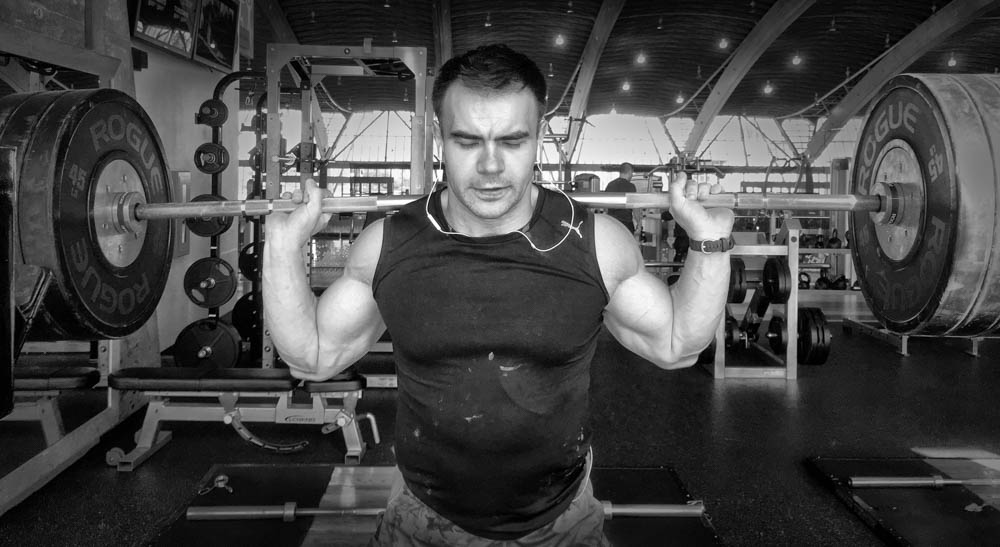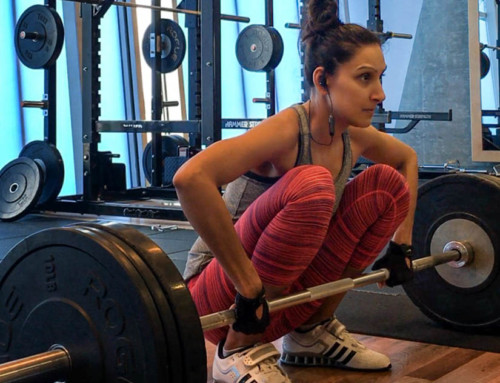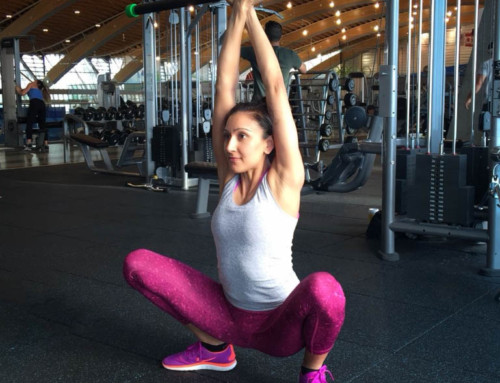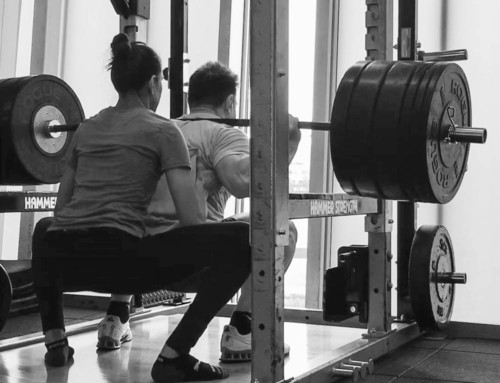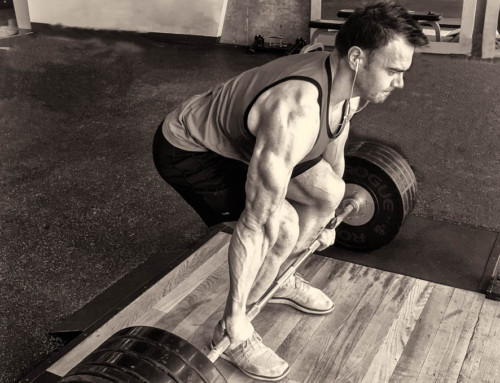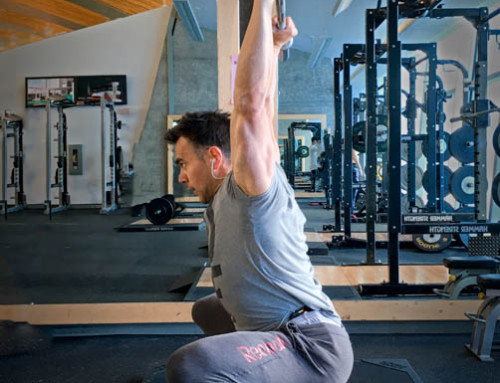Art of the squat is a popular and passionate topic, that has been and continues to be debated throughout textbooks, sport magazines and internet channels. Squat itself is simple but technical requiring proper positioning of your body through balance, joint mobility and flexibility. To sit down into a bottom position and stand up out of it, engages vast number of muscles, bones, joints and connective tissue—all participating throughout each state of the movement.
Considered as the king of exercises, squats improve overall strength and develop quads, glutes and trunk stability. Furthermore, squats place mechanical stress on many other muscles in stability or assistance roles. All this mechanical stress directly influences metabolic stress by engaging muscles to spend energy, generating micro-trauma within working tissues (a good thing) as the result in order to produce force. The body’s response to the aftermath – accumulated metabolic stress – is to elevate its repair and recovery processes including:
- more lean tissue,
- improving connective tissue elasticity, and
- burning a lot of body fat for energy to support these extensive adaptations.
There are number of squat exercises in existence, each designed to elicit a particular effect. Also, each squat exercise can be further specified with additional variety by using different foot positions, equipment and cadence in performing the lift itself. With all the different options available, there is a squat exercise that is a preferred fit for each one of us. When performed correctly, squats not only improve muscle tone but entire body systems, including:
- Central Nervous System (CNS),
- circulatory system,
- immune system and
- endocrine system to name a few.
At Science and Strength, we love to squat and experience all the physical and mental benefits that come with it. Squat technique, set-up and achieving desired range of motion (ROM) are all great topics but are beyond the scope of this article. In this post, we’ll discuss squat versions that are predominantly used within our Stronger Leaner Faster training protocols.
Squat Goals
For fitness advice, it seems that no matter where you look, be it textbooks, magazines or internet posts, squatting has been the common prescription method to achieve results in record time. Squats are the common denominator of all physical benefits discussed above. Additionally, squatting is a natural body movement and practicing this exercise at bodyweight or under load promotes strength, mobility and balance.
At Science and Strength, we pursue greater body functionality through continuously training our biomotor abilities. The Stronger Leaner Faster (SLF) system strives to develop physical potential where you have the ability to produce force, for longer, more efficiently and with proper biomechanics. To do that, strength is at the forefront of SLF skill development goals. However, strength also carries over its ability into other motor skills.
Squats being a functional exercise are a great vessel to achieve SLF objectives by developing proper neural patterns through practicing proper form performed with full range of motion (ROM), while concurrently increasing speed, endurance, mobility, flexibility and balance. Advancing our biomotor abilities decreases the risk of injury while improving vitality of knee joints.
There have been numerous articles on how squats are bad for the knees. However, Science and Strength’s extensive research and practical experimentation show that squatting with proper form improves knee stability and strengthens associated connective tissue. To achieve these goals, SLF programs use back, front and split-stance style squats. These variations produce great carryover effect, engage numerous muscles in a coordinated manner during exercise and force production.
Squat Variations and Benefits
If you ever heard that performing exercises should be based on personal ability and physical makeup—this is a true statement for the squat. Squat is a movement and needs to be recognized as such. In order for anyone to perform this movement, he or she needs to understand their own body mechanics, joint angles and areas that require further development. Because of all these contributing factors, each person setup and performing this exercise will be slightly different than the other.
Having said that, common proper techniques for each squat variety is a blueprint to a strong guiding foundation of the lift and its progression. After learning the movement and its physical demands on the body, the next stage is to improve it. To take advantage of the squat’s functionality, you first need to know your goals and then initiate a path unique to personal physical attributes.
For us at Science and Strength, functionality is achieved by continuously developing physical skill sets of this movement through the following squat exercises:
- Front Squat
- High Bar Back Squat
- Bulgarian (aka Split Stance or 1-Legged) Squat
- Goblet Squat
- Cossack Squat
Each squat exercise is practiced through scheduled periodization programs along with personal minute adjustments in order to create the ideal position and best movement patterns.
High Bar Squat
As mentioned before, squat is an exercise that has a high “carryover effect” and High Bar Back Squat demonstrates it like no other exercise. By doing more back squats with bar placement right across the traps, develops athletic style of strength. Strong high bar back squatters often exhibit better explosive performance through faster accelerations, greater verticals and longer jumps. The exercise is quad dominant which consist of both fast twitch (type II) and slow twitch (type I) muscle fibers. Engaging greater leg drive builds more of each muscle fiber type as well as its recruitment patterns, so that the body is ready to produce more force faster.
The bar path with any barbell squats should be aligned (more or less) with the middle of the foot. Higher bar placement creates a more upright body position throughout the squat in order to generate adequate torque through joint angles. Setup of the squat position should be experimented in order to find something that compliments natural ability and physical makeup.
For us, the set up is more of a tighter package including hand placement just outside the shoulder width and feet between shoulder and hip line in a staggered position. Hands are tight squeezing the bar with elbows covering the arm pits with chest out and hips directly under the bar. This requires shoulder mobility and again, hand position will depend on individual goals, physical ability and previous injuries.
Movement of the squat is through full ROM, going below parallel. The depth is once again a personal decision and will depend on your body’s mobility and stability. Being able to maintain natural spine curvature and posterior pelvic tilt (aka butt wink) will play a role in the depth ability of this exercise. This upright body position forces greater knee flexion at the bottom squat position requiring greater ankle (especially Dorsi-flexion – bringing the toes towards your shins) as well as hip mobility. Also, by getting out of the below parallel hole places majority of force producing responsibility onto the quadriceps, as the gluteus muscles don’t really kick-in until the body passes 90 degrees of concentric contraction. To actively maximize quad power, the core is extensively challenged through bracing and keeping truck resisting the bar in an upright position, while the force is aggressively produced through the mid-foot.
Mobility is a contributing factor for numerous functional movements, and high bar back squat quickly reveals any limitations through body angles. Also, due to its upright positioning throughout the movement, high bar back squat has a high carryover effect towards other exercises and physical activities. Olympic weightlifting (clean and jerk, and the snatch) along with jumping (vertical and horizontal) distances all shown to have a common dynamic strength increase through proficient high bar back squatting.
Front Squat
If you thought high bar back squats puts great emphasis on quads, wait until you try the front squat. The bar placed across the upper chest, clavicles and front deltoid, and is secured through the “clean” grip (as in olympic weightlifting clean) with elbows high creating a 90 degree angle between arms and the body. The foot position is similar to high bar back squat; some may find a slightly narrower stance (under or just outside the hip line) to be more comfortable. If you thought core strength was important in the back squat, it is paramount here with the front version. The entire truck is greatly engaged by flexing lower and upper back while bracing the abdominal wall throughout the movement.
Additionally, front squats require significant muscular coordination as well as quad strength. As in high bar back squat, front squat requires good ankle, hip, shoulder and wrist joint mobility due to great knee traction and bar placement. At Science and Strength the cross-arm grip is not used as it produces less secure bar grip and the rounding of the upper back due to bar displacement during continuous repetitions.
Front squats develop strength and lean tissue within the quads like no other exercise. Also, forces you to acknowledge any mobility issues, thus improving this important biomotor ability as the result simultaneously increasing ROM to below parallel. Practicing this form of squat translates into many dynamic style movements including Olympic lifts and other power development skills, which are inline with SLF training goals.
Bulgarian Split Squat
Bulgarian split squat is type of a hybrid that engages hip and knee flexion at same time. Due to its front foot loading Bulgarian split squat effectively improves balance by incorporating more hamstings, gluteus’ and abdominal wall. Bulgarian is often referred to as a unilateral exercise (one side), however both legs perform the movement. Each leg is positioned in a lunge style stance engaging appropriate muscles to generate force. The front leg bears more of the load, incorporating the squat movement through quads, gluteus muscles and hamstrings; as the rear foot controls decent improving hip flexor flexibility.
Split leg position forces the body to perform the Bulgarian in a controlled manner by activating more stabilizer muscles than in a standard squat. Practice will increase the carryover effect towards any running or sprinting style activity. Due to increased flexibility, Bulgarian squats lower risk of injury. Also, loads used in this version are often lighter than in standard squats, however the benefits are on par with many bilateral lower body exercises. Improving biomotor abilities is a priority at Science and Strength; hence the Bulgarian split squat is a standard component to SLF training repertoire.
Staggering your feet, placing the back foot flat on top the bench while the front foot pointing straight on the floor. If you suffered an ankle injury, keeping the rear foot caulked on the ball of the foot is an acceptable alternative, thus increasing hip flexor activity through slightly raised rear leg position. Keep the trunk upright, chest up and control the eccentric contraction of front leg, stopping just before rear knee touching the ground. On the way up, use both legs (in different positions) to generate force during concentric contraction. Exploding out of the hole in a lunge foot stance develops a ton of power which directly improves other dynamic exercises. Because of its unique benefits, Bulgarian split squat and its variations are placed throughout SLF periodization protocols including dynamic warm-ups, main development exercises and accessory lifts.
Goblet Squat
Goblet is an excellent pre-requisite to learn the squat. By holding onto a dumbbell or kettlebell, you sit down between the legs in a natural position while tracking the knees in an outward direction. Foot position depends on the person, and for us, it is the same set up as in high bar back squat. Goblet is a good introduction or accessory exercise for anyone wishing to learn the squat or develop proper movement pattern.
With smaller weights held against the chest, goblets are easier to coordinate allowing more focus on squat mechanics. Also, among the learning quest comes the engagement of the upper and mid back. Majority of gym goers let the bar loose on the back without any control nor tension. Learning how to activate back muscles leads to overall posterior chain health with less injuries down the line. Goblet squat is a good warm-up and accessory exercise, allowing you to attain depth while focusing on technique.
Cossack Squat
If you never heard or performed the cossack, you’ve been missing out. Named after the old Russian style cultural dance of the cossacks, this squat variation moves across several body planes (coronal and sagittal). Basically, you take up a wide foot stance with staggered feet and squat sideways towards one leg, while the other leg extends straight. After the bottom position with one loaded leg, you reverse the movement towards starting position.
This odd looking movement improves lower body joint mobility (hips, knees and ankles) and connective tissue engagement and elasticity. Also squatting sideways places different demands on loading and trailing leg independently, exposing joints, ligaments and tendons to greater angles throughout the movement. Transitioning between the loading and extending leg action improves overall ankle, knee and hip health, increasing overall ROM while reducing risk of injury.
Cossacks are predominantly done as an assistance exercise as well as variation of it is completed during dynamic warm-up prior to beginning of a training session.
Final Thoughts
Squat has been considered by many as the king of exercises and for the right reasons. This movement improves joint mobility, and creates a tremendous amount of mechanical and metabolic stress. Squats improve strength, speed, flexibility and balance through building more muscle tissue, burning body fat and increasing bone and connective tissue health. Different squatting protocols can further enhance other biomotor abilities including power, endurance and agility.
To achieve all the benefits of this movement, be sure to utilize number of squat versions including: high bar back squat, front squat, Bulgarian split squat, Cossack squat and goblet squat.
We hoped you enjoyed this article, if so, please share it on your favourite social media so, we can get on google’s radar. Fell free to leave us a comment and start a discussion on the topic.
You may also be interested in learning more about our Books:

